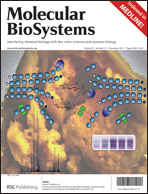PNA as a potential modulator of COL7A1 gene expression in dominant dystrophic epidermolysis bullosa: a physico-chemical study†
Abstract
Dominant diseases are single gene disorders occurring in the heterozygous state. The mutated allele exerts a dominant effect because it produces an abnormal polypeptide that interferes with the function of the normal allele product. Peptide Nucleic Acids (PNAs) offer a route for a potential therapy for dominant diseases by selectively silencing the allele carrying the dominant mutation. Here, we have synthesized and studied the properties of a 15-mer PNA fully complementary to the site of the c.5272-38T>A sequence variation, which identifies a recurrent mutant COL7A1 allele causing dominant dystrophic epidermolysis bullosa (DDEB), a mendelian disease characterized by skin blistering. The PNA was conjugated with four lysine residues at the C-terminus and a fluorescent probe at the N-terminus. Physico-chemical results proved the formation of a stable, selective PNA/mutant-DNA heteroduplex in vitro. Intriguingly, when transfected into normal human fibroblasts, the PNA correctly localized in the cell nucleus. Our results open new therapeutic possibilities for patients with DDEB.


 Please wait while we load your content...
Please wait while we load your content...